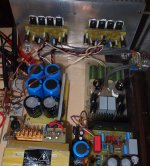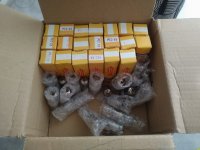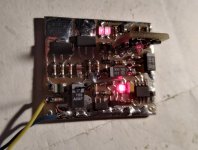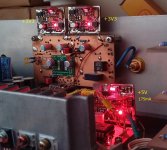No thanks. Sowters IV transformers have several benefits:
Galvanic isolation to isolate DAC ground noise etc
Output 5 or 10x the input so no additonal amplification needed.
Filtering of common mode noise
Very low DC primary resistance.
No output offset issues.
Galvanic isolation to isolate DAC ground noise etc
Output 5 or 10x the input so no additonal amplification needed.
Filtering of common mode noise
Very low DC primary resistance.
No output offset issues.
I personally do not like transformers in the signal path, especially for IV conversion which I believe must be active in any case in order to get the maximum performance of the DAC itself. For example the PCM1794 where TI recommends an active IV stage with as much gain as possible to get the most out of the PCM1794 itself.
Normally, everyone has their own choice as it suits them.
Normally, everyone has their own choice as it suits them.
I guess this means you don't like tube amps either !
Yes, it's each to his own.
I expect TI make the very opamps theu recommend for their dacs. if they made transformers things might have been different......
Yes, it's each to his own.
I expect TI make the very opamps theu recommend for their dacs. if they made transformers things might have been different......
Well, honestly, I have not yet found a tube amplifier with which I would be satisfied and I listen everything from classic and jazz to techno. But, that's why I made a hybrid amp without NFB that used a 6S4P as a voltage amplifier and laterals in the output, I was satisfied with it because I canceled out the shortcomings of the transformer in the output.I guess this means you don't like tube amps either !
Soon I will start making something similar but this time with ECC88(PCC88) due to better availability and distribution so that anyone can assemble that amplifier.
Attachments
I use PCC88s in my R2R DAC buffer between dac & transformers. They measured better than ECC88s and work fine on 12.6v. DC.
I guess this means you don't like tube amps either !
Yes, it's each to his own.
I expect TI make the very opamps theu recommend for their dacs. if they made transformers things might have been different......
I think you are extrapolating and applying things the way you deem suitable to you and the point you are trying to make, but during that process, you did make an error; in particular, you failed to see vastly different use-case scenarios between tube amps and transformers, and low current out DACs and transformers.
Transformers in valve gear are used due to high voltages/stage coupling issues/ extracting AC signal from the DC & superimposed AC signal... therefore, they are simply required and the necessary evil (unless OTL).
AD811 has something that no other IC has... a very low input impedance while providing great speed. The way Jung used it allows DAC to see virtual 0 dynamic input impedance. It is vastly superior to AD844; however, AD811 needs to be implemented properly to prevent oscillations. Also, AD811 does not like capacitors with long leads, the resistors should be non-inductive as well....
But with a very low current-out level like PCM1704 for example, AD811 is unparalleled as an I/V converter.
Transformers will colour the sound and slow the DAC substantially. They are far from being a good choice for DAC I/V. Maybe for something with a lot of current-out (1794), they may provide okay-ish sound, but in this particular case (1794), the simple high-quality resistor (TX2575) will work much better.
Grunf,Today I finished the prototype PCB for IV with AD811 but this time everything with SMD components except four 100uF/50v ukz and two AD811 with heatsinks.
For the first time I used DALE PNM non-magnetic series instead of RN60, and instead of polystyrene and polypropylene TH capacitors I used non-magnetic SMD COG capacitors. AD811 is soldered direct on the PCB.
So far I can say that in this application the PNM is much better than the RN60.
I looked for these PNM resistors and the selection of available values is extremely small at Mouser and DK. I normally use Susumu RG, RS, RR in the signal path, but would be willing to try these. Where did you source them?
@Vunce ,I bought these from Mouser, but as you say the offer is quite bad, I hope it will be fixed in the future because these are excellent resistors, at least around AD811 😉 .
I normally use Vishay MELF for everything and I don't think much about it, but here I deliberately went for a better resistor. AD811 is a demanding op amp so everything around it plays a role, that was the primary reason for the new PCB with much smaller traces that can only be obtained only in SMD.
btw; I didn't get any reply to my last pm.
I normally use Vishay MELF for everything and I don't think much about it, but here I deliberately went for a better resistor. AD811 is a demanding op amp so everything around it plays a role, that was the primary reason for the new PCB with much smaller traces that can only be obtained only in SMD.
btw; I didn't get any reply to my last pm.
Today the DAC got a new regulator, it is again Walt Jung UnivReg_122714 but an improved version and the first complete SMD version. Op amp in reg is ADA4625-1 and output voltage is 5V/120mA to pin22(output interface) on PMD100 . It is interesting that in the DAC, the regulators themselves contain four ADA4625-1 and four ADA4897, the voltage range is from 3.3V to 14V(negative and positive).
But more importantly, DALE PNM non-magnetic are a perfect match for AD811 and I recommend them for this I/V stage. Unfortunately, the problem is poor availability, as @Vunce says, but the values 1K, 50K and 33R, all 1206 are available and just what I need for my setup. The problem arises with a different DAC current when the feedback needs to be adjusted. There is also a PTN version that is not non-magnetic and Mouser has a few more choices above 1K.
But more importantly, DALE PNM non-magnetic are a perfect match for AD811 and I recommend them for this I/V stage. Unfortunately, the problem is poor availability, as @Vunce says, but the values 1K, 50K and 33R, all 1206 are available and just what I need for my setup. The problem arises with a different DAC current when the feedback needs to be adjusted. There is also a PTN version that is not non-magnetic and Mouser has a few more choices above 1K.
Attachments
Last edited:
It's been more than two weeks since the new regulator was installed. At first, the sound was a little weak in the bass, but now it's a completely different story. Unfortunately, tanatals that work at 1V in the regulator take a long time to play properly, I had a similar experience with 3.3V shunt regulators. In general, they need more time than standard electrolytes in this position. As far as I can see, UKZ is no longer available for purchase at Mouser, so these tantalums are a great choice instead. The sound of the DAC itself is now on a new level and this again gave me new guidelines when making my new DAC with PCM1794A.
Attachments
I have to thank Walt Jung for these regulators and 1V references and I have to admit that this is the best regulator I've tried so far for digital in a DACs, incomparably better than the LT3042, ADM7150 and other regulators on the market, whether discrete or integrated.
For those who are interested in making, I think these few links would be enough;
https://refsnregs.waltjung.org/UnivReg_122714.pdf
https://refsnregs.waltjung.org/An_Improved_Reference_Filter_for_Audio_Regulators.pdf
https://refsnregs.waltjung.org/LEDs_as_Audio_Voltage_References_P2.pdf
For those who are interested in making, I think these few links would be enough;
https://refsnregs.waltjung.org/UnivReg_122714.pdf
https://refsnregs.waltjung.org/An_Improved_Reference_Filter_for_Audio_Regulators.pdf
https://refsnregs.waltjung.org/LEDs_as_Audio_Voltage_References_P2.pdf
have you tried TDK NP0 capacitors? they are better in quality than polystyrene and polypropelene
https://www.eevblog.com/forum/metro...-multi-slope-converter/msg2763326/#msg2763326
https://www.eevblog.com/forum/metro...-multi-slope-converter/msg2763326/#msg2763326
I highly recommend LME49720HA (Metal Can) as I/V and OPA192 as LPF/SE conversion section for PCM1794. This couple is doing impressive things with my cheap dual PCM1794 DAC. I tried many combinations with differen opamps but LME49720HA /OPA192 combination has a kind of sound that strictly apart every other opamp combination and commercial DAC I've ever listen.
LME49720 = LM4562 rigth ? Very sensible to EMC/EMI, some find it not so good sounding in an input stage. But I don't know with the differential output of the pcm1794, have you tried op1633 in spite of the LME49720 here?
Anyway this a CFB OP thread here, so off topic, sorry for that.
Anyway this a CFB OP thread here, so off topic, sorry for that.
After a quick look at the data sheet of the LME49720, the specs are indistinguishable from an LM4562. I'm talking about exact same numbers! It's uncanny. I wonder if they are the same part? In any case, I've been a big fan of the sound of the LM4562 for a number of years so I will have to try that in my I/V stage. I never thought of doing that. Right now my DAC in progress will use an AD811. Thanks for the tip.I highly recommend LME49720HA (Metal Can) as I/V and OPA192 as LPF/SE conversion section for PCM1794. This couple is doing impressive things with my cheap dual PCM1794 DAC. I tried many combinations with differen opamps but LME49720HA /OPA192 combination has a kind of sound that strictly apart every other opamp combination and commercial DAC I've ever listen.
I had them as samples when they were still in production. You can find them in Swap Meet forum for sale, if you interested.@terranigma where do you buy metal can ones? they are obsolete afaik
I'm talking about metal-can one. Even designer engineers confirmed that metal-can ones are sounding better in many occasions.LME49720 = LM4562 rigth ? Very sensible to EMC/EMI, some find it not so good sounding in an input stage. But I don't know with the differential output of the pcm1794, have you tried op1633 in spite of the LME49720 here?
Anyway this a CFB OP thread here, so off topic, sorry for that.
https://www.diyaudio.com/community/...g-audio-integrated-opamps.154106/post-3699617
https://www.diyaudio.com/community/...g-audio-integrated-opamps.154106/post-5543194
Yes, off-topic but it is the "final sound" we are all being going after anyway. Maybe LME's current-feedback metal-can counterpart LME49713 is the actual thing that we have to consider. It is the National engineer's (audioman54) favorite part as long as i remember.
I tried OPA1612 as a SOTA reference, it sounded boring (like rolled off) on every occasion. Just like my $2K top-end commercial DAC (measures 123dB SINAD, one of the best) which uses them. NE5532 and NJM2114 are better sounding ICs in my opinion.
After the sound I got with PCM1794, I stick with this DAC and this is almost a 20 years journey.
- Home
- Source & Line
- Digital Line Level
- AD811 as I/V stage for current DACs (and test some other opamps including Burson Audio opamps as I/V)




